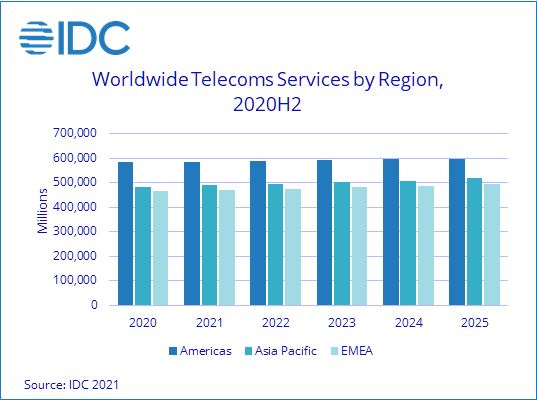
Telcos have evolved from merely supplying their customers with telephony or broadband services, but also look to provide a setlist of Internet-based services such Pay TV.
While this offering has brought providers with new sources of revenue, during 2020, these services slumped with telco revenues totaling $1.53 trillion in 2020, representing flat year-over-year growth, according to the International Data Corporation (IDC) Worldwide Semiannual Telecom Services Tracker.
Forecasts for the coming year by IDC suggest that worldwide spending will increase by 0.7 percent in 2021 to reach a total of $1.54 trillion; however, with YoY numbers witnessing a minimal hike, it indicates that telco revenues will go through a slow recovery process.
“The COVID-19 pandemic was unquestionably the most important factor influencing the telco market in 2020. In the first six months of the year, the pandemic brought a notable decline to the market in the form of decreased subscriber numbers and lower services spending,” the IDC report highlighted.
This was caused by the strict lockdowns imposed by governments as well as the widespread pessimism and anxiety that forced people to cut spending on nonessential products and services.
In the second half of the year, the demand recovered, fueled by economic stimulus measures and the progress in vaccine development. The renewed optimism helped the global and regional markets to cover the losses recorded in the first half of the year and come close to equaling the prior year’s results, IDC experts noted.
Although the revenue outcome in 2020 was neutral, the pandemic drastically changed the trends that have shaped the global telco market for a long time.

Consumer fixed data services have suddenly become the most important type of connectivity, enabling home-bound people to work and entertain. Business fixed data services have temporarily lost momentum due to the migration of traffic to the consumer segment, but most of these connections were preserved as they were protected by long-term contracts.
In parallel, fixed voice services saw a slight increase in dropout rates because some companies within the small business segments went bankrupt and more residential clients gave up their connections for cost-cutting purposes.
Mobile services spending also declined slightly due to slower renewal of contract agreements, reduction of out-of-bundle spending, and a sharp decrease in roaming revenues due to travel restrictions.
In the Pay TV segment, the migration from traditional Pay TV to Over the Top (OTT) services accelerated during the COVID-19 crisis, driven by increased consumption of video content and new OTT service launches.
IDC experts believe that connectivity will become an even more critical asset for households and businesses after the pandemic, as some of the habits adopted during the crisis (remote working, collaboration, online media consumption) are expected to become part of everyday life.
According to the report, the migration toward FttP access is expected to accelerate in most of the country markets, while the business fixed data market will recover in the longer term as the economic recovery drives increased investments in the cloudification of enterprise business activities.
Revenue growth in the mobile services space will be buoyed to a degree by 5G adoption, which will invite users to deploy more advanced data capabilities and uptake the content and services dependent on high-speed data connectivity, IDC expressed.
The global telco market was put to a serious test in 2020 and it successfully passed. IDC believes that the lessons learned last year will help the industry to secure stable growth in the coming period. “The COVID-19 pandemic demonstrates the resilience and value of the telecoms industry,” said Chris Barnard, vice president, European Infrastructure and Telecoms.
“New ways of working will persist beyond the pandemic, shaping future revenue opportunities, while the network-centricity of consumers will drive bandwidth requirements in that segment as well,” Barnard added.